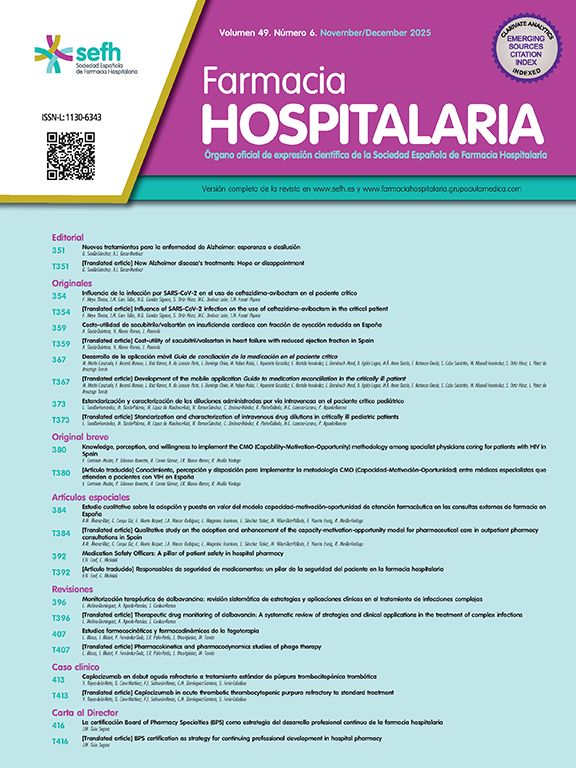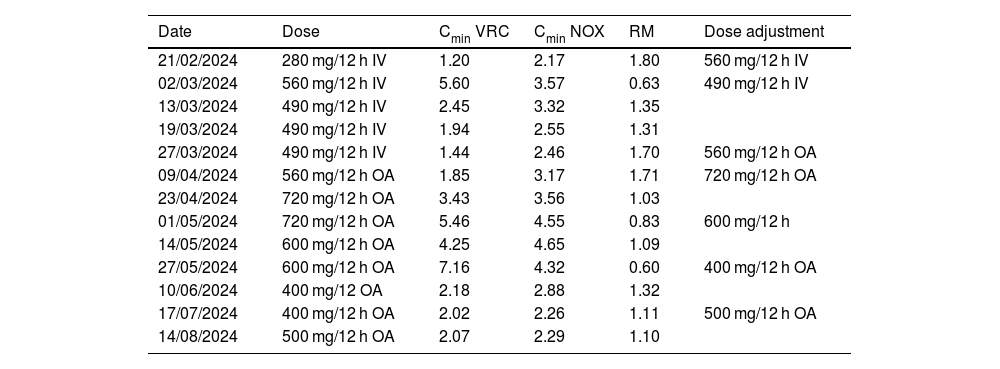Voriconazole is an antifungal agent used to treat severe fungal infections, including invasive aspergillosis. Pharmacokinetic monitoring is recommended due to its high inter- and intra-individual variability, significant risk of interactions, non-linear pharmacokinetics, and the presence of genetic polymorphisms.1
Voriconazole is metabolised in the liver, mainly by the CYP2C19 isoenzyme, resulting in an inactive metabolite, voriconazole N-oxide.2 Useful therapeutic information can be obtained by determining the N-oxide minimum concentration (Cmin) and calculating the metabolic ratio (MR).3 The MR is calculated as the ratio between N-oxide Cmin and voriconazole Cmin.
A high MR and N-oxide Cmin are characteristic of patients with a rapid metabolizer phenotype, whereas a low MR and N-oxide Cmin are characteristic of slow metabolizers. This rules out the influence of other factors, such as drug interactions or liver dysfunction.4
We present a case study of a patient with invasive aspergillosis who was treated with voriconazole. The measurement of N-oxide Cmin and the determination of the MR were crucial in identifying the metabolic phenotype and guiding dose adjustments.
Case descriptionA 68-year-old man was admitted to the intensive care unit (ICU) of a tertiary hospital with septic shock and multiple organ failure caused by a respiratory infection. During his stay, his clinical condition caused pathophysiological alterations including haemodynamic instability, impaired renal and hepatic function, hypoglycaemia, and neurological disturbances with severe polyneuropathy.
Given the presence of fever, increased levels of acute phase reactants, and respiratory deterioration with severe bronchospasm, a microbiological culture of bronchoaspirate (BAS) and bronchoalveolar lavage (BAL) fluid was requested, as well as testing for fungal markers in respiratory and serum samples.
Following the isolation of Aspergillus sp. from BAS and BAL cultures, and a positive serum galactomannan, treatment with the standard dose of intravenous isavuconazole was initiated due to suspected invasive aspergillosis.
Computed tomography scans confirmed pulmonary and cerebral involvement. Therefore, 10 days later, treatment was changed to voriconazole, as clinical evidence more strongly supports its use in invasive aspergillosis5 and its high lipophilicity facilitates penetration into brain tissue.6 Intravenous voriconazole was started with a loading dose of 420 mg every 12 hours (6 mg/kg), followed by a maintenance dose of 280 mg every 12 hours (4 mg/kg).7
The pharmacy department conducted pharmacokinetic monitoring of voriconazole using the MwPharm program (Mediware, Czech Republic) with Bayesian adjustment, targeting a therapeutic range of 2 μg/mL to 5.5 μg/mL.3,7 The samples were sent to the National Microbiology Centre. Voriconazole Cmin and N-oxide Cmin were measured by liquid chromatography.
The first measurement was conducted 7 days after the patient started voriconazole: voriconazole Cmin = 1.20 μg/mL, N-oxide Cmin = 2.17 μg/mL, and MR = 1.80. As genetic profiling is not routinely available at our centre, and given the urgency of the situation, we used MR as an indicator of the patient's metabolic phenotype.
According to the consulted therapeutic algorithm,3 when the voriconazole Cmin is between 1 and 2 μg/mL and the MR is greater than 1.15, the patient is considered a rapid metabolizer. Therefore, the dose should be increased by between 33% and 50%. Based on this recommendation, we increased the dose to 560 mg every 12 hours (8 mg/kg).
Another measurement was taken 10 days later: voriconazole Cmin = 5.60 μg/mL, N-oxide Cmin = 3.57 μg/mL, and MR = 0.63. This pharmacokinetic variability can be explained by the nonlinear pharmacokinetics of voriconazole, coupled with the pathophysiological alterations caused by the patient's critical condition.8 Therefore, a slight dose reduction to 490 mg every 12 hours (7 mg/kg) was recommended, taking into account the rapid metabolizer phenotype. Fig. 1 and Table 1 show how the weekly measurements remained within the therapeutic range.
Chronological course of dose adjustments and plasma concentrations of voriconazole (μg/mL) and N-oxide (μg/mL).
| Date | Dose | Cmin VRC | Cmin NOX | RM | Dose adjustment |
|---|---|---|---|---|---|
| 21/02/2024 | 280 mg/12 h IV | 1.20 | 2.17 | 1.80 | 560 mg/12 h IV |
| 02/03/2024 | 560 mg/12 h IV | 5.60 | 3.57 | 0.63 | 490 mg/12 h IV |
| 13/03/2024 | 490 mg/12 h IV | 2.45 | 3.32 | 1.35 | |
| 19/03/2024 | 490 mg/12 h IV | 1.94 | 2.55 | 1.31 | |
| 27/03/2024 | 490 mg/12 h IV | 1.44 | 2.46 | 1.70 | 560 mg/12 h OA |
| 09/04/2024 | 560 mg/12 h OA | 1.85 | 3.17 | 1.71 | 720 mg/12 h OA |
| 23/04/2024 | 720 mg/12 h OA | 3.43 | 3.56 | 1.03 | |
| 01/05/2024 | 720 mg/12 h OA | 5.46 | 4.55 | 0.83 | 600 mg/12 h |
| 14/05/2024 | 600 mg/12 h OA | 4.25 | 4.65 | 1.09 | |
| 27/05/2024 | 600 mg/12 h OA | 7.16 | 4.32 | 0.60 | 400 mg/12 h OA |
| 10/06/2024 | 400 mg/12 OA | 2.18 | 2.88 | 1.32 | |
| 17/07/2024 | 400 mg/12 h OA | 2.02 | 2.26 | 1.11 | 500 mg/12 h OA |
| 14/08/2024 | 500 mg/12 h OA | 2.07 | 2.29 | 1.10 |
IV, intravenous; NOX, N-oxide; MR, metabolic ratio; OA, oral administration; VRC, voriconazole.
Six weeks later, as the patient's condition had improved, so he was switched to oral administration. As voriconazole is 96% bioavailable via this route, the dose was increased to 560 mg every 12 hours (8 mg/kg). After spending 113 days in the ICU, he was transferred to the inpatient ward due to haemodynamic stability and neurological and respiratory improvement. Fifteen days later, he was discharged to an intermediate care hospital, for follow-up by the infectious diseases unit of the referral hospital.
We continued to measure voriconazole and N-oxide concentrations, making dose adjustments guided by the therapeutic algorithm and the results of the pharmacokinetic programme. Initially, these were performed every 15 days, subsequently there were performed monthly basis (Fig. 2 and Table 1). The patient was treated with voriconazole for a total of 208 days.
Following radiological improvement of the pulmonary and cerebral lesions, negative BAS culture results, a better pharmacokinetic profile, and lower associated toxicity, the patient was switched to isavuconazole for 238 days.
DiscussionThe N-oxide Cmin and MR are key parameters for monitoring the pharmacokinetics of voriconazole. They indicate the drug's metabolic capacity at a given time and can help anticipate and guide dose adjustments, particularly in complex clinical situations.
Boglione-Kerrien et al. developed a therapeutic algorithm based on MR, using the results of their multivariate model, to improve the pharmacokinetic monitoring of voriconazole and optimise dose adjustment. They demonstrate how MR can be an additional tool for understanding the variability of the drug.3
The significant variability of voriconazole has been widely documented. Encalada et al. reported an interindividual variability in Cmin of 75.6% and an intraindividual variability of 40.1%, which explains the observed fluctuations in concentrations in our patient.9
This case study demonstrates that using the MR-based algorithm to identify the metabolic phenotype is useful for optimising voriconazole treatment in patients with suspected altered metabolism. It can be used alongside CYP2C19 genotyping as a complementary tool. In fact, this algorithm has been incorporated into our routine practice.
Ethical responsibilitiesThe patient gave informed consent for this case to be published.
Declaration of authorshipThe authors of this manuscript submitted to the Farmacia Hospitalaria journal declare that they have all participated substantially in its preparation, correction, and approval.
CRediT authorship contribution statementIrene Orozco Cifuentes: Writing – review & editing, Writing – original draft. Adrián Domínguez García: Writing – review & editing. María Jiménez Meseguer: Writing – review & editing. Elena García Benayas: Writing – review & editing. Benito García Díaz: Writing – review & editing.
FundingNone declared.
None declared.










